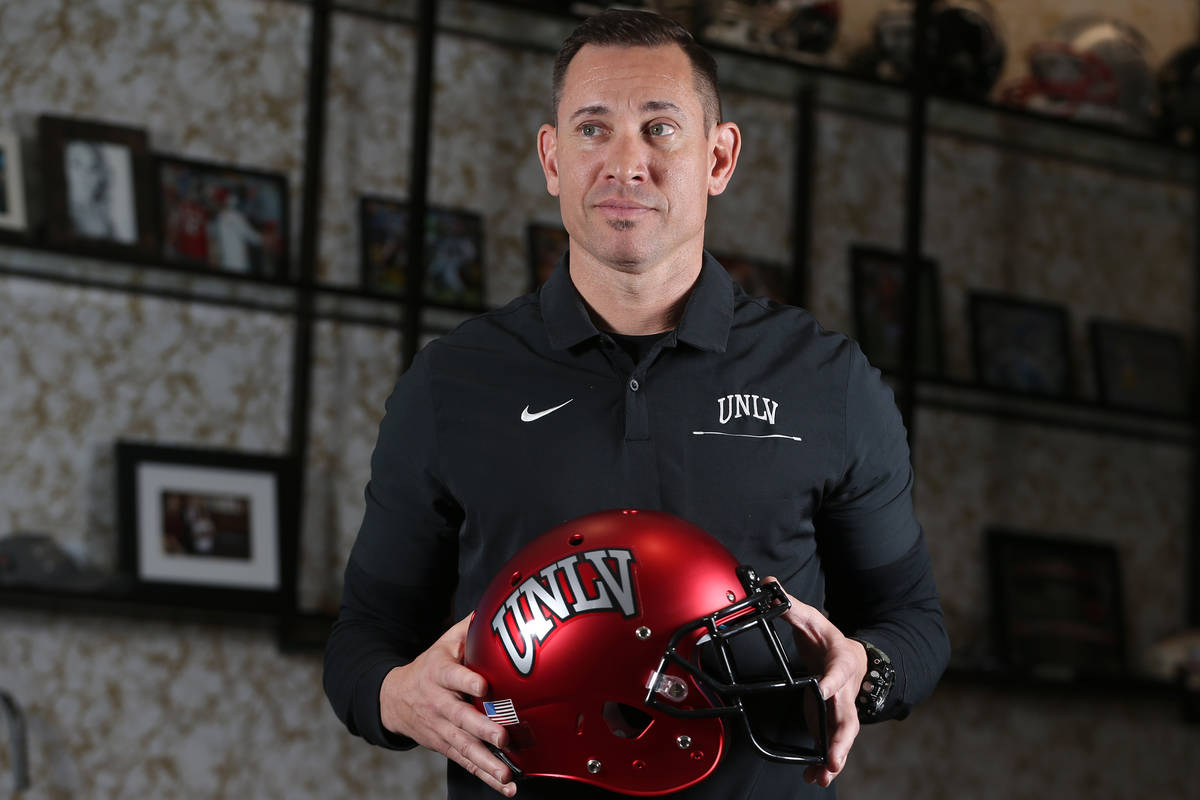Marcus Arroyo tracks new ways to build UNLV football
Marcus Arroyo says he’s a better person now. A better football coach. Better in all ways forwhat has transpired.
COVID-19 has caused us to re-examine those professional habits we always believed most effective. Which ones to alter. Which ones not to. Arroyo as a first-time head coach has taken a peek.
UNLV has a fall schedule, the Mountain West on Thursday releasing an eight-game league slate that has the Rebels opening under Arroyo when meeting San Diego State in Carson, California, on Oct. 24.
UNLV then plays its inaugural game at Allegiant Stadium against UNR on Halloween night. Maybe in front of some fans. Maybe not. It won’t matter to a cannon.
It’s all still a big mystery, no? Which college teams will emerge from a coronavirus pause the most efficient. Which can avoid the sorts of injuries that have already taken from the NFL some of its most celebrated players. Which know how to best use a fancy GPS tracker.
Don’t knock it. The tracker could be the difference between winning or losing against Boise State here Dec. 5. Well, that and like 150 other things.
Information helps
But in following what he embraced at previous coaching stops, Arroyo’s use of the Catapult GPS system is unquestionably foremost in him building a roster capable of not burning out midway through those eight games. It’s also used by nearly 3,000 teams from all sports and levels across the world.
Performance level. Soft tissue injury prevention. When to push tempo at practice. When to back off. The data provided Arroyo and has staff from those player trackers would be invaluable in even the most ordinary of training camps. This is hardly that.
“I know right now what we can load our guys with because we had these (trackers) on them in conditioning drills,” Arroyo said. “I know the gas tank of each guy. I can know our load in the middle of practice and know we’re running hot. So then I can slow practice down.”
I’m the world’s worst driver. Such a GPS tracker might at any time sound an alarm as I load my front end into the car ahead of me while my blood pressure begins to run hot. In terms of Arroyo, I just think it means he knows when dudes are tired.
Still, there is never such a thing as too much information. Especially now. So whether it’s Arroyo depending on what a physiological tool tells him about his team’s fitness capabilities, or having its hydration levels checked more often than Tom Brady, or studying how various professional sports returned to action following lockouts or strikes (he has done that also), more power to him.
There was no spring football. This is it. In the past, a coaching staff might gather for a depth chart organizational meeting after the team’s first scrimmage weeks into camp. Arroyo held one after four practices. This might be the first time he has seen UNLV football players as, well, UNLV football players, but the clock isn’t on anyone’s side right now.
“We have no idea what these guys can do in this defense or offense,” Arroyo said. “I know their physical tools and body movements. I don’t think the pandemic happening has much to do with this part. You could have a million reps before this and it doesn’t matter. Every position is open.”
His message, then, to the team: Coaches will teach players what they need to know about the new schemes. Players will tell coaches who’s starting based on the understanding and execution of said schemes. Coaches don’t need a GPS tracker for that. Just eyes and ears.
Looking back
When this time has passed and a much larger sense of normalcy returns, Arroyo hopes to look back and assess what exactly worked and didn’t when preparing for such a season. Said he might even discover a coach doesn’t need to literally live in his office to get the same amount of work accomplished.
It’s all a mystery now. UNLV has a schedule of eight games. He knows that. He knows they are set to play four at Allegiant Stadium and four away from it. He knows when things have hit their load or are running hot. He knows Brady drinks a lot of water.
“We’re better people for this,” Arroyo said. “We focused on a lot of human elements that were right in our face. We’re better coaches. We’re more patient. We have found multiple ways to teach. We had to create new ways to do stuff.”
Wow — near 770 words later. That’s it for now. I’m running hot.
Ed Graney is a Sigma Delta Chi Award winner for sports column writing and can be reached at egraney@reviewjournal.com or 702-383-4618. He can be heard on “The Press Box,” ESPN Radio 100.9 FM and 1100 AM, from 7 a.m. to 10 a.m. Monday through Friday. Follow @edgraney on Twitter.


















